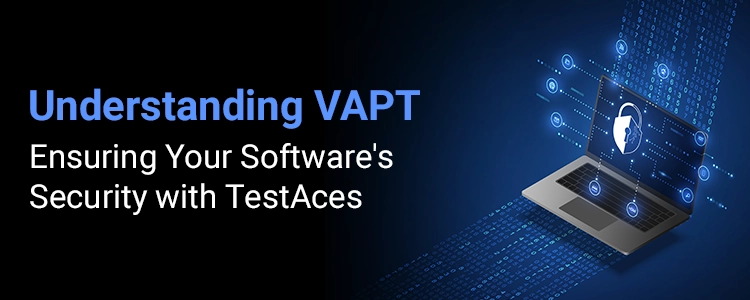
Understanding VAPT: Ensuring Your Software's Security with TestAces
As software becomes central to everything from business operations to personal finance, security must be treated as a priority—not an afterthought. With cyberattacks growing both in complexity and volume, the need for reliable methods to identify and resolve vulnerabilities before attackers exploit them has become paramount. This is where VAPT—Vulnerability Assessment and Penetration Testing—comes into play. A crucial part of any organization’s cybersecurity strategy, VAPT not only uncovers security flaws but also helps mitigate future risks effectively.
This blog explores how VAPT services play a vital role in software security testing, the difference between vulnerability assessments and penetration testing, and why businesses must prioritize securing their applications using these powerful techniques.
What Is VAPT?
VAPT is a comprehensive process that combines two critical elements of cybersecurity:
- Vulnerability Assessment (VA) – This involves scanning systems and applications to identify known vulnerabilities. It’s an automated and systematic process that gives a wide-ranging overview of potential security weaknesses.
- Penetration Testing (PT) – This goes a step further by simulating real-world cyberattacks on applications, networks, or systems to exploit the discovered vulnerabilities. The goal is to understand the impact and severity of a successful attack.
While vulnerability assessments help in spotting known issues, penetration testing evaluates how those issues could be used against your system. Together, they form a proactive, layered defense strategy.
Why VAPT Matters More Than Ever
The modern software development lifecycle is fast, agile, and continuous. While this pace supports rapid innovation, it also increases the chances of security flaws slipping through. Integrating software security testing within the development pipeline is essential, but not enough. VAPT offers a focused approach that mimics how hackers think and operate.
One of the core values of penetration testing is that it helps organizations think like attackers. By understanding how vulnerabilities could be exploited, companies gain deeper insight into what needs to be fixed—not just what exists. This real-world simulation is a major reason behind the rising penetration testing importance in today’s security-conscious environments.
How VAPT Strengthens Software Security
From customer-facing web portals to backend APIs and mobile applications, every digital touchpoint is a potential target for attackers. Securing applications with VAPT means ensuring that every layer of your software infrastructure is tested against multiple threat scenarios. Here's how it helps:
-
1. Early Detection of Vulnerabilities
By integrating VAPT early in the development or deployment stages, teams can catch critical issues before software goes live. This early detection saves both cost and reputation.
-
2. Better Compliance and Risk Management
Industries governed by regulatory frameworks—like finance, healthcare, and e-commerce—often mandate periodic security assessments. VAPT helps ensure compliance with standards like ISO 27001, PCI DSS, and GDPR while providing valuable risk metrics to management.
-
3. Holistic View of Security Posture
Traditional testing may confirm that code behaves as expected, but VAPT reveals whether that same code is resilient against real attacks. This broader perspective allows organizations to understand their actual defense capability.
-
4. Customized Reporting and Recommendations
Another important aspect of professional VAPT services is the detailed reporting. Beyond identifying issues, reports often include tailored remediation advice. This makes it easier for developers and IT teams to prioritize and resolve problems efficiently.
The Penetration Testing Process: A Brief Walkthrough
While vulnerability assessment relies more on automated tools, penetration testing blends automation with manual expertise. Here's a simplified view of how it typically works:
- Scoping: Defining the boundaries of what will be tested—application, network, APIs, etc.
- Information Gathering: Collecting data about the system or application to understand its structure and logic.
- Threat Modeling: Identifying how the system might be attacked.
- Exploitation: Attempting to exploit vulnerabilities to measure severity.
- Reporting: Documenting vulnerabilities, attack paths, and actionable remediation steps.
By replicating tactics used by malicious actors, penetration testers can discover vulnerabilities that static scanning tools often miss.
Common Vulnerabilities Detected Through VAPT
From misconfigurations to outdated software libraries, here are some common security lapses identified through software security testing via VAPT:
- SQL Injection
- Cross-Site Scripting (XSS)
- Broken Authentication
- Insecure APIs
- Sensitive Data Exposure
- Unpatched Components
- Misconfigured Cloud Services
Each of these vulnerabilities, if left unchecked, can lead to devastating breaches, making the case stronger for regular, professional testing.
Choosing the Right VAPT Partner
The effectiveness of a VAPT exercise depends heavily on the experience and expertise of the team conducting it. A competent provider will offer:
- A mix of automated and manual testing
- Experienced security analysts
- Detailed, human-readable reports
- Industry-specific compliance insights
- Collaborative vulnerability remediation support
When selecting a partner, businesses should look for proven capability in handling complex systems, as well as a transparent methodology.
Final Thoughts
The digital age has created infinite possibilities for innovation, but it has also expanded the attack surface exponentially. Security is no longer optional—it is foundational.
Penetration testing importance continues to grow because it doesn’t just tell you what’s wrong, but shows you how those weaknesses can actually be exploited. VAPT equips organizations with this foresight.
Securing applications with VAPT is not just about meeting compliance checklists. It’s about building customer trust, protecting data, and sustaining long-term business continuity. As threats evolve, so must our defenses—and VAPT remains one of the most effective tools in that evolution.
Why Choose TestAces?
If you’re looking to elevate your application’s security through end-to-end, expert-led VAPT, TestAces offers the precision, depth, and agility that modern organizations need. With a commitment to continuous learning, real-time threat analysis, and tailored testing frameworks, TestAces brings together experience and innovation to help secure your digital future—one vulnerability at a time.